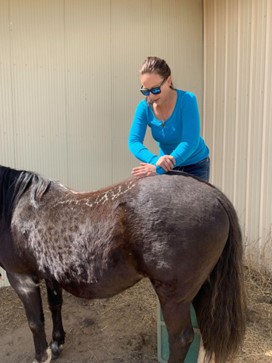The majority of ailments in the horse is in their feet. Published podiatry literature cites as high as an 89% incidence in foot abnormalities in the horse!
“No foot, No horse,” is a phrase with undeniable truth throughout history as horses were critical in battles as noted in this poem:
For want of a nail, the shoe was lost;
For want of the shoe, the horse was lost;
For want of the horse, the rider was lost;
For want of the rider, the battle was lost;
For want of the battle, the kingdom was lost;
And all for the want of a horseshoe nail.
This poem was traced back to the fall of Rome finally ascribing it to a blacksmith oversleeping one morning!
Undeniably, history truly shows how the foot of a horse is still as important now as it was in the past.
The nervous system is the most important system in any species, and in the horse, most of the nerves are in the foot. (As opposed to the human where the brain has that honor.)
The experience and educational background of our veterinarians allows for a more in-depth approach yielding greater success on podiatry cases at Colorado Equine Clinic. Our process is to gather detailed history from you as the owner and your farrier about your horses’ environment, exercise and use, lameness, changes in hoof capsule shape or form, and shoeing frequency and history. With this information, your horse will receive a thorough clinical examination of all four feet for shape and size, then will be tested for pain using hoof testers and percussion. Then, an assessment of how your horse’s foot accepts load and moves through the air is evaluated on a special concrete motion analysis site designed by Dr. Page to incorporate sound of load with the visible evaluation. Movement at a canter will be done in the outdoor arena. Additional diagnostics including diagnostic nerve and/or joint blocks, and leverage tests are done if needed. Radiographs are evaluated using podiatry radiographic software provides an improved understanding of which tissues are pathologic.
The most successful treatment occurs when options are discussed among you, the farrier, and the veterinarian with your horse at the consultation. Once options are decided, trimming and shoeing with considerations from all parties and the data provided by the examination is done. Changes in the horse’s movement and demeanor are evaluated throughout the trim and shoeing process. Adjustments can be made at that time if needed to obtain as much normal function of the foot as possible.
Much of the success with podiatry comes because the CEC team assures all three functions of the horse’s foot are considered and incorporated into the treatment. This is accomplished first through the trim. The shoe is then chosen which will contribute to the function of life needed by the horse and not provided by the pathologic foot.
Dr. Page works closely with our farrier, Mike O’Donnell, to ensure the best shoeing decisions are made for your horse.
For more information, please refer to the website for the International Foundation for Equine Podiatry Research (IFEPR.org) Dr. Page founded to promote education and research on the equine foot.






